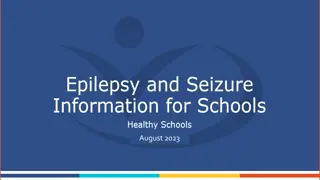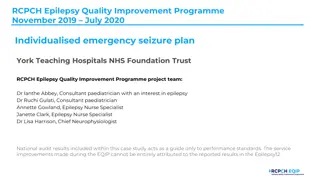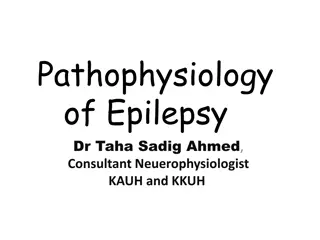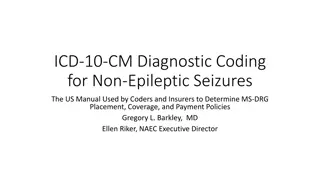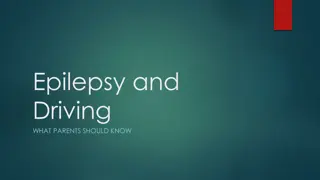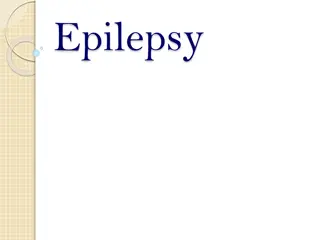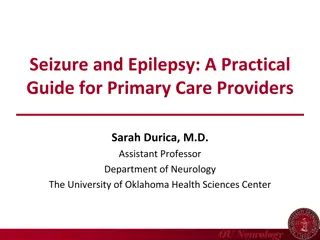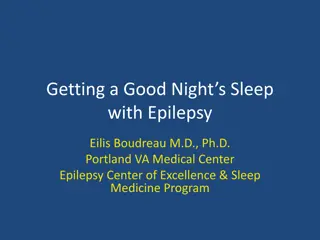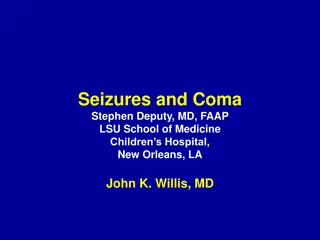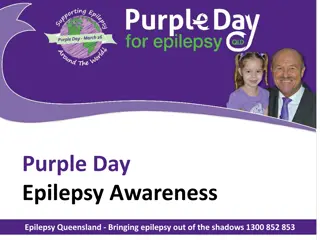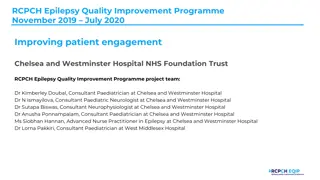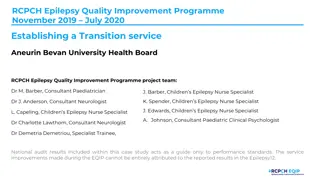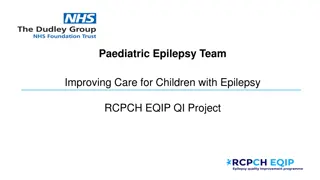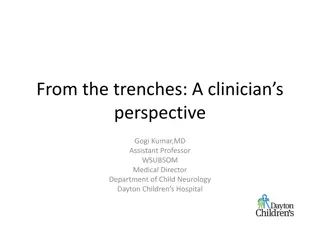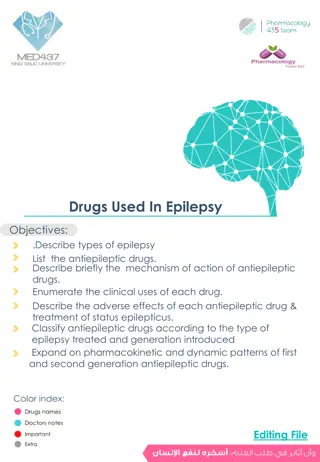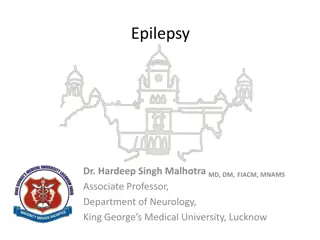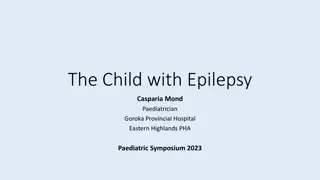
Understanding Epilepsy: Causes, Symptoms, and Management
Explore the world of epilepsy through this comprehensive training module which covers the basics of epilepsy, different types of seizures, diagnosis, treatment options, and seizure triggers. Gain insights on how to recognize and support individuals experiencing epileptic seizures, and understand the neurological complexities of this condition. Enhance your awareness and knowledge to provide better assistance to those with epilepsy.
Download Presentation

Please find below an Image/Link to download the presentation.
The content on the website is provided AS IS for your information and personal use only. It may not be sold, licensed, or shared on other websites without obtaining consent from the author. If you encounter any issues during the download, it is possible that the publisher has removed the file from their server.
You are allowed to download the files provided on this website for personal or commercial use, subject to the condition that they are used lawfully. All files are the property of their respective owners.
The content on the website is provided AS IS for your information and personal use only. It may not be sold, licensed, or shared on other websites without obtaining consent from the author.
E N D
Presentation Transcript
Highfield Schools Medical Awareness Training
Aims: To understand what Epilepsy is Epilepsy Awareness To recognise how different seizures can present themselves To recognise how to support someone experiencing an epileptic seizure To recognise the potential dangers to a person with Epilepsy
Epilepsy is a neurological disorder affecting the brain Someone diagnosed with epilepsy means they have had more than one epileptic seizure Around 1 in every 103 people in the UK have Epilepsy Possible causes of Epilepsy are: Brain damage Head injury Epilepsy Basics Stroke An infection such as Meningitis Some people do not know what has caused their Epilepsy There are many different types of Epilepsy syndromes such as Lennox-GastautSyndrome and some present themselves in different ways.
Electrical activity is happening in the brain all of the time A seizure happens when there is a sudden burst of intense activity at the same time This results in a temporary disruption to how the brain is working How seizures affect a person depends upon the part of the brain that is being affected. Epileptic Seizures Some people lose consciousness, some experience strange sensations, the body may twitch or jerk, some people fall to the floor and shake. Seizures can last between a few seconds or minutes.
Epilepsy is diagnosed by a specialist. They sometimes rely on eyewitness accounts and descriptions of presentations of seizures. Individuals may have EEG s, blood tests and scans in the diagnostic process Epilepsy is normally treated with Anti EpilepticDrugs (AED s). They don t cure the Epilepsy but manage the symptoms How is Epilepsy Treated? Some individuals have a ketogenic diet which is strictly controlled to help manage the symptoms and seizures There is also VagusNerve Stimulation (VNS) which is fitted to some individuals which helps to delay or prevent seizures when onset is detected
Sometimes seizure activity is focussed in one part of the brain only, with others it can then spread to other parts of the brain and become a more generalised seizure Seizures can have a variety of triggers such as tiredness, temperature or smells. Individuals can also have photosensitive epilepsy where light conditions can trigger seizures. Types of Epileptic Seizure There are two main groups of seizure which we will learn about in more detail: Focal Generalised
This seizure is focussed just in one part of the brain. Depending upon where in the brain the activity is focussed depends upon how the seizure presents Frontal lobe moving head or eyes from side to side, difficulty speaking, screaming/swearing/laughing, unusual or repeated body movements Temporal lobe lip smacking, strange sensations, feeling frightened, staring, feeling frightened Occipital lobe eye pain, fluttering eyes, seeing things that are not there, rhythmic eye movements Parietal lobe numbness/tinging/altered sensation, dizziness, difficulty understanding language, marching sensation in the body Focal Seizures https://www.youtube.com/watch?v=6srVMZsYEKM These can act as a warning to a precursor to a generalised seizure.
In a generalised seizure activity happens in both sides of the brain and a person can lose consciousness They can cause a person fall down and their body to stiffen and jerk. There are 5 different types of generalised seizures: Generalised Seizures Tonic Clonic Tonic Clonic individuals may stop breathing. In the tonic phase individuals will fall to the floor, body go stiff and lose consciousness. In the clonicphase limbs will jerk, they may bite their cheek or tongue and they may lose bowel or bladder control https://www.youtube.com/watch?v=olArThAgUd8
During a tonic seizure the body stiffens and eyes roll backwards. There may be a loss of consciousness. Falls can be sudden and without warning and individuals are prone to head injuries because of this. Generalised Seizures Tonic Chest muscles can tighten so breathing can be impaired. Lips may go blue and breathing will need to be closely monitored. They can last 60 seconds. They commonly occur in clusters. https://www.youtube.com/watch?v=pjmDY3tR6ak
Atonic Seizures These seizures are commonly called drop attacks. Individuals lose all muscle tone and they can drop to the floor. The seizure is normally very brief and the person is able to get up straight away. Generalised Seizures Atonic & Myoclonic https://www.youtube.com/watch?v=EEusUYl5uQ4 Myoclonic Seizures Persons muscles jerk, this can be mild like a twitch or forceful. They last for a fraction of a second and can be singular or in clusters https://www.youtube.com/watch?v=s8JrRuWfHOw
These occur in children and adults. They can occur singularly or repeatedly. They occur for a few seconds and individuals stop what they are doing prior to the seizure. Generalised Seizures - Absence They are very hard to spot and a pupil might appear to be daydreaming or switching off They are not aware of what is happening and cannot be bought out of it https://www.youtube.com/watch?v=JpPQbkMEYW8
A person having a seizure can expend a lot of energy. This can mean after the seizure they are very tired. After a Seizure They can also be: Confused, have headaches, memory problems, behaviour changes, cognitive difficulties.
Most seizures are brief and can last seconds or minutes. Usually a person's seizures will last the same amount of time each time they have a seizure. Sometimes a seizure can develop into Status Epilepticus. Status Epilepticus & Seizure Management This is where a seizure lasts longer than 30 minutes or there is a repetitive cycle of seizures for longer than 30 minutes with no break in between. Where a person is in convulsive Status Epilepticus this is a medical emergency An ambulance must be called for a seizure lasting longer than five minutes or longer than what is usual for them. At all times staff must follow the medical protocol attached with that individual and act accordingly to administer rescue medication.
Each individual with Epilepsy will have a care plan or protocol. This demonstrates what to do in an emergency and describes the seizure type in detail You will be asked to read and sign protocols of individuals you are working with to ensure that you understand your responsibilities. Seizure Management It will be detailed DURING A SEIZURE DO NOT: Try to restrict the patients movements Place fingers in the mouth to attempt to remove tongue Give a second dose of rescue medication at school
Within an individual's protocol there may be rescue medication prescribed. Buccolam comes in a pre-filled syringe which is administered into the buccal cavity in the mouth. Half is to be put in one side and half the other. ONLY administer according to the individuals protocol. Rescue Medication How to administer Buccolam: https://www.youtube.com/watch?v=B08WEXzXVo4
SUDEP stands for Sudden Unexplained Death in Epilepsy. This is relatively rare but individuals need to ensure they are aware that this is a risk that is associated with Epilepsy. SUDEP Can happen during or following a seizure More common in individuals with frequent convulsive seizures

